Landscape for Play
Playground Intermediae
Pº de la Chopera, 14
28045 Madrid
Spain
Hours: Tuesday–Friday 4–9pm,
Saturday–Sunday 11am–9pm
What spaces can artists imagine for boys and girls to play? How can a cultural institution experiment and offer new experiences for children?
Landscape for Play
The London-based studio Aberrant Architecture has turned the Intermediæ exhibition space in Matadero Madrid, into a large installation that invites spontaneous and unregulated play. Inspired by the architectural language of the great Dutch playground designer Aldo van Eyck (1918-99), Landscape for Play invites children to discover all the possibilities of their own movements.
Van Eyck designed and built more than 700 playgrounds, thereby transforming the urban landscape of Dutch cities. His playing areas were made up by simple geometric elements that favored imaginative uses. To the question of how we can transform the urban space through play in the 21st century, Aberrant Architecture replies with structures, shapes and objects that favour independence and self-organization. The resulting interior landscape is composed of follies, crevices and different elevations which, although they make up a fantastic territory that can be used by the communities that come to Intermediæ each day, don’t impose rigid restrictions in how people must behave.
Aberrant Architecture is a multiple award-winning collaborative studio of designers, makers and thinkers whose projects introduce new and unexpected ways of experiencing everyday life. Aberrant design interactive architecture, interiors, public art, exhibitions & installations, building close relationships with the communities in which they operate.
Playgrounds Intermediae
Landscape for Play continues Intermediæ’s work on childhood through commissions to interdisciplinary artists to design spaces for play. With these Playgrounds, Intermediæ - Matadero highlights the need to dedicate more spaces for children in contemporary cities. Furthermore, by taking the risk to invite children to play inside its galleries, Matadero Madrid also makes a unique statement about the role of young people inside cultural institutions.
These grand-scale commissions to international artists are part of Intermediæ’s ongoing research into children’s rights, subversive maternities, and upbringing in contemporary cities; an investigation strand that will continue until the year 2021 with the involvement of different groups and agents.
To respond to these concerns, Intermediae has invited different artists, researches, policy makers as well as citizens to reflect on the concept of “play” and its possible derivations. Their proposals—some constructive, others intangible—take as their starting point the belief that through play and the resulting disruption of institutionalized norms of behavior, it is possible to generate new social relations. In this way, by favouring unexpected appropriations and uses of and within the institution, Intermediae endeavours to create other poetics and actions while at the same time producing sensitive yet complex environments in which to co-exist. These explorations take place mainly in the gallery, but they also extend to other locations inside and outside the grounds of Matadero Madrid.
In the autumn of 2019, the Spanish artist Leonor Serrano Rivas will be opening the next experimental indoor playground. Her project looks at the early stages of visual perception development in humans by creating a shadow theatre on the ceiling of the gallery. To coincide with this new playground, Intermediæ will organize an international seminar to discuss with other cultural institutions what place do children occupy in today’s museums, galleries and contemporary art centres.
About Intermediæ - Matadero Madrid
Intermediæ is a programme of Matadero Madrid-Center for Contemporary Creation devoted to the production of transdisciplinary artistic projects based on experimentation and shared learning. Childhood, ecology, the assertion of personal memories, civic engagement, mediation, and the right to the city are some of the issues that articulate a collectively generated proposal.


